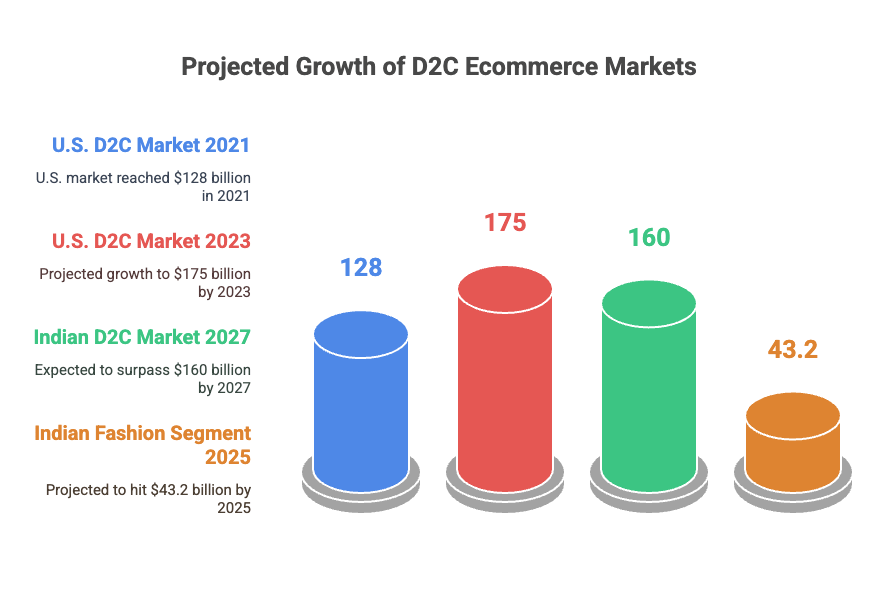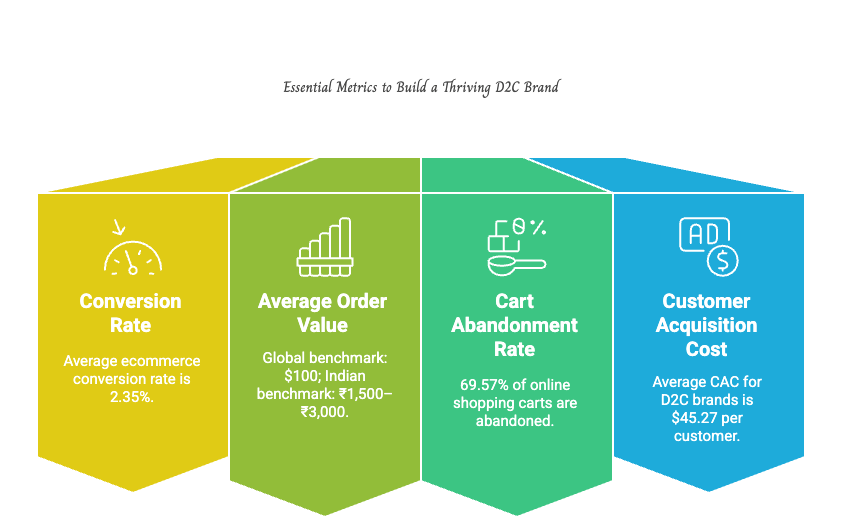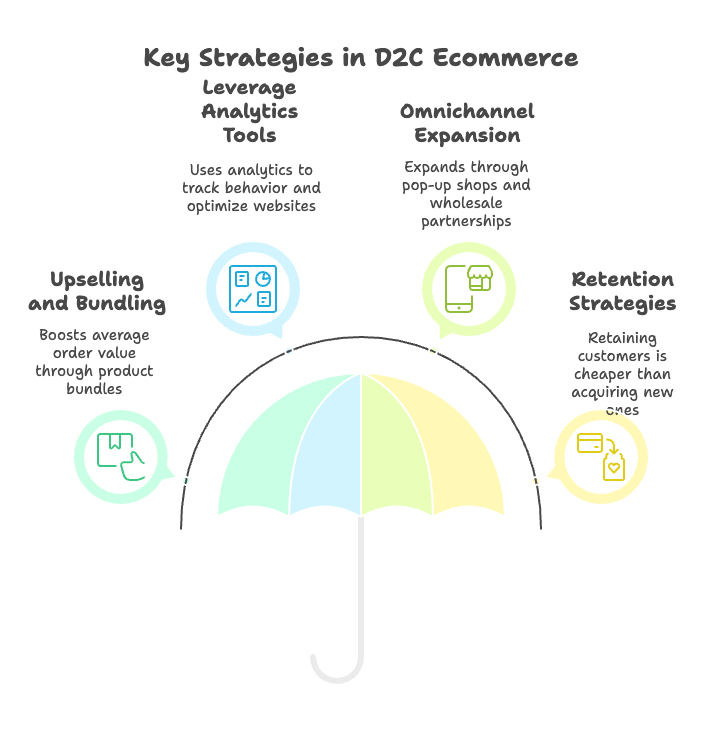Building a direct-to-consumer (D2C) brand has become incredibly popular among entrepreneurs who want a deeper connection with their customers and greater control over their brand’s journey. The D2C ecommerce market is booming, with sales expected to reach $175 billion in the U.S. by 2023. If you’re looking to dive into this exciting business model, this guide is here to help you every step of the way.
So, what exactly is the D2C business model? Simply put, it’s when a brand sells directly to its customers instead of going through traditional retail channels. This approach allows brands to have full control over everything—products, marketing, pricing, and customer relationships.
The D2C model has some fantastic benefits:
- Build direct relationships with your customers and get genuine feedback
- Increase profit margins by cutting out the middlemen
- Maintain complete control over your brand messaging and customer experience
- Gather valuable customer data to improve your strategy
- Quickly adapt to market changes
However, with great power comes great responsibility. As a D2C brand, you’ll need to manage everything yourself—from creating your website to acquiring customers and handling logistics. It’s no wonder that nearly half of UK ecommerce SMBs see D2C sales as their biggest growth opportunity despite the challenges.
Let’s get started on building your dream D2C brand!
Understanding the D2C Business Model
At its core, direct-to-consumer (D2C) means that a brand connects directly with its customers, bypassing traditional retail channels or intermediaries. This approach allows brands to have complete control over their products, marketing strategy, pricing, and relationships with customers.
The D2C model offers several clear benefits:
- You build a direct relationship with your customers, making it easier to gather and act on feedback.
- You can increase your profit margins by cutting out middlemen.
- You have complete control over how your brand is presented and the customer experience.
- You can collect valuable customer data to enhance your strategy.
- You can quickly adapt to changes in the market.
However, this level of control brings its own set of challenges. D2C brands need to manage everything themselves, from creating their website to acquiring customers and handling logistics—tasks that retail partners traditionally manage. This is why nearly half of UK ecommerce small and medium-sized businesses view D2C sales as their biggest opportunity for growth, despite the hurdles involved.
In the end, building a D2C brand means taking on both the rewards and responsibilities, allowing you to shape your business and connect with your customers in meaningful ways.
Step 1: Define Your Brand Identity and Niche
Identifying Your Unique Selling Proposition (USP)
In today’s crowded D2C marketplace, standing out has become more important than ever. Long gone are the days when direct-to-consumer brands could grow with little effort. Your first step is to define exactly what makes your brand unique.
Your Unique Selling Proposition (USP) should tackle:
- What problem are you solving for your customers?
- How does your solution improve upon existing options?
- What unique value do you provide that your competitors don’t?
Differentiating your brand starts with innovation at the product level. Focus on perfecting one product before expanding your offerings. This helps establish a clear place in consumers’ minds and sets a strong foundation for your brand identity.
Identify Your Niche
Begin by thoroughly researching your market to identify gaps and opportunities that align with your expertise and interests. Successful D2C brands typically address specific pain points or improve upon existing products in meaningful ways.
- Analyse competitors’ offerings, pricing strategies, and customer feedback
- Conduct surveys and interviews with potential customers
- Identify trending products or categories with growth potential
- Evaluate market size and potential profitability
Define Your Target Audience
Developing detailed buyer personas is crucial for D2C success. These should include demographic information, shopping behaviours, pain points, and motivations. The more precisely you can define your audience, the more effectively you can tailor your products and marketing.
Crafting Your Brand Story
Your brand story should resonate deeply with your target audience, creating a genuine and memorable connection. Think of this narrative as sharing a heartfelt conversation, including:
- The core values and mission that fuel your brand’s passion
- The inspiring tale behind the brand’s inception—what motivated you to start this journey
- The hopeful vision of how your brand will make a positive impact on customers’ lives
As you develop your brand’s identity, ensure every visual element (logo, colour scheme, typography) and your brand voice (be it professional, playful, inspiring, or edgy) align consistently. This coherence helps in forging strong recognition and establishing trust with your audience.
Step 2: Research and Product Development
Market Research and Competition Analysis
Before launching a D2C brand, thorough market research is essential. Study your target audience’s preferences, pain points, and buying behaviours. Analyse competitors to identify gaps in the market that your brand can address.
When evaluating product opportunities, consider:
- Market size and growth potential
- Competition intensity
- Profit margins
- Production complexity
- Shipping considerations

Product Development and Quality Assurance
The success of a D2C brand heavily relies on offering products that exceed customer expectations. Without physical stores where customers can examine products before purchasing, quality becomes even more crucial in building trust.
Develop a rigorous quality assurance process that includes:
- Prototype testing with potential customers
- Manufacturing partner selection and vetting
- Quality control standards and procedures
- Return policy development
The trade-off here involves balancing product quality with cost-effectiveness. While premium materials and manufacturing processes increase costs, they can also justify higher price points and foster customer loyalty through satisfaction.
Product Creation Strategy
When developing your product, consider these approaches:
- Create a proprietary product that solves a specific problem
- Improve upon existing products with better design or features
- Curate and resell existing products with unique positioning
Finding reliable suppliers is critical for product-based D2C brands. You’ll need to decide between domestic and overseas manufacturing, weighing factors like cost, quality control, minimum order quantities, and lead times.
Pricing Strategy
D2C brands typically employ one of several pricing models:
- Premium pricing that emphasizes quality and exclusivity
- Value-based pricing that undercuts traditional retail
- Subscription models that generate recurring revenue
When determining your pricing strategy, account for product costs, operating expenses, customer acquisition costs (which average $45.27 in the D2C space), and desired profit margins.
Step 3: Building Your Online Store
Selecting the Right Ecommerce Platform
Your online store is the digital storefront and operational hub of your D2C business. When choosing an ecommerce platform, consider:
- Ease of use and technical requirements
- Customization options and design flexibility
- Built-in marketing features
- Payment processing capabilities
- Mobile responsiveness
- Scalability as your business grows
Website Design and User Experience
Your website should clearly communicate your brand identity while providing a seamless shopping experience. Key elements include:
- Clean, intuitive navigation
- Fast loading speeds
- High-quality product imagery and descriptions
- Simple checkout process
- Mobile optimization
- Trust signals (reviews, security badges, clear policies)
The challenge here is balancing aesthetics with functionality. A visually stunning site that’s difficult to navigate will frustrate customers, while an overly simplified design might not effectively communicate your brand story. Finding the right balance is essential for converting visitors to customers.
Setting Up Your Ecommerce Infrastructure
Choose Your Ecommerce Platform
Selecting the right ecommerce platform is crucial for D2C success. Leading options include:
- Shopify (powers over 1 million businesses worldwide)
- WooCommerce (flexible open-source solution)
- BigCommerce (enterprise-level features)
- Magento (highly customizable but more complex)
When selecting a platform, consider factors like ease of use, customization options, scalability, and integration capabilities with other business tools.
Essential Website Elements
Your D2C website should include:
- Mobile-optimized design (over 70% of ecommerce traffic comes from mobile devices)
- Fast loading speeds (conversion rates drop by 4.42% for each second of load time)
- High-quality product images and videos
- Clear product descriptions highlighting benefits
- Simple checkout process (the average cart abandonment rate is 69.57%)
- Trust signals including reviews, guarantees, and security badges
Step 4: Marketing and Customer Acquisition Strategies
Customer Acquisition Channels
One of the biggest challenges for D2C brands is acquiring customers without the built-in traffic of retail stores. D2C brands typically acquire customers through several channels:
- Organic search and SEO
- Ranking for industry keywords drives organic traffic to your site. This requires consistent content creation and technical optimization.
Social media marketing
With 85% of Gen Z shoppers saying social media impacts their purchasing decisions, platforms like Instagram and TikTok have become crucial for D2C brands. A strong social media strategy should focus on building community and showcasing your brand personality.
Influencer partnerships
Collaborating with influencers, particularly micro and nano influencers with highly engaged audiences, can build credibility and reach new customers. The key is selecting influencers who authentically align with your brand values.
Paid advertising
Many D2C brands launch and grow through strategic paid ads across Facebook, Instagram, Google, and other platforms. The challenge is managing rising customer acquisition costs while maintaining profitability.
Content marketing
Positioning yourself as a trusted source of information builds credibility and attracts potential customers. This could include blog posts, videos, or social media content addressing your audience’s interests and pain points.

Building Authenticity and Trust
In today’s world, especially among younger generations, consumers crave genuine connections with the brands they support. Here’s how you can build trust and authenticity:
- Share behind-the-scenes glimpses that showcase real people and processes.
- Involve your team members as brand ambassadors; let their voices shine.
- Be transparent about every aspect of your business, from manufacturing to pricing.
- Own up to your mistakes and demonstrate how you’re working to correct them.
While aggressive acquisition strategies might boost short-term sales, nurturing authentic relationships will cultivate loyal customers and ultimately reduce long-term acquisition costs. Remember, committing to genuine engagement today sets the foundation for sustainable growth tomorrow.
Step 5: Logistics and Fulfilment
Supply Chain Management
Managing logistics can be one of the toughest parts of running a D2C business. When you’re selling directly to consumers, you’re in charge of everything from making the products to getting them delivered right to your customers’ doors.
Here are some things to keep in mind:
- Making sure you have enough products in stock
- Setting up warehouses and fulfilment centres
- Choosing the right shipping partners and managing costs
- Creating smooth return processes
- Handling international logistics if you’re selling worldwide
It’s all about finding the right balance between speed and cost. Fast shipping makes customers happy, but it can also be expensive. The goal is to meet your customers’ expectations without breaking the bank.
Customer Service Excellence
Outstanding customer service is non-negotiable for D2C brands. This includes:
- Responsive support across multiple channels
- Clear communication about order status
- Hassle-free returns
- Proactive resolution of issues
- Personalized assistance
Investing in customer service technology like chatbots can help manage inquiries efficiently while maintaining the personal touch customers expect from direct relationships with brands.
Step 6: Scaling Your D2C Brand
Data-Driven Decision Making
As your D2C brand grows, leveraging data becomes increasingly important for informed decision-making. Areas to monitor include:
- Customer acquisition costs by channel
- Customer lifetime value
- Conversion rates at each stage of the funnel
- Product performance metrics
- Customer feedback and reviews
Expanding Product Lines and Markets
Once your core product has captured the market’s interest, think about branching out strategically:
- Consider adding new product variations based on customer feedback
- Introduce complementary products that enhance your main offerings
- Explore international markets where there is demand
- Add new sales channels, but keep D2C as your primary focus
The key challenge during this phase is maintaining your brand identity and ensuring product quality as you scale operations. Many D2C brands struggle during rapid growth because they compromise on the elements that made them successful.

Step 7: Overcoming Common D2C Challenges
Rising Customer Acquisition Costs
As more brands enter the D2C space, customer acquisition costs continue to rise. To combat this:
- Focus on retention marketing to increase customer lifetime value
- Implement referral programs to leverage word-of-mouth
- Optimize conversion rates to maximize return on ad spend
- Build community through content and experiences
- Test emerging platforms before competition intensifies
Building Brand Awareness
Standing out in a crowded digital landscape requires creativity and consistency:
- Develop a distinctive visual identity that’s immediately recognizable
- Maintain consistent messaging across all touchpoints
- Consider strategic partnerships with complementary brands
- Look for PR opportunities to increase visibility
- Create shareable content that extends organic reach
Managing Logistics Complexity
As your order volume grows, managing logistics can become a real juggling act:
- Think about partnering with third-party logistics (3PL) providers as your business scales.
- Invest in good inventory management software to keep track of your stock.
- Regularly review and negotiate with shipping carriers to ensure you’re getting the best rates.
- Consider setting up multiple fulfilment centres to get your products to customers faster.
- Have a backup plan for any potential supply chain hiccups.
Running a D2C business means finding that sweet spot between control and efficiency. While keeping everything in-house gives you maximum control, smart outsourcing of certain tasks can boost your operational efficiency as you grow.
Building a Sustainable D2C Brand
Building a successful D2C brand from scratch is both a challenging and fulfilling journey. It requires a mix of creativity, careful planning, and a deep commitment to understanding and serving your customers. The direct connection with consumers offers invaluable insights that can drive continuous improvement and growth.
The most successful D2C brands stand out by being innovative with their products, providing exceptional customer service, and sharing authentic stories. They skilfully balance growth and profitability, control and efficiency, speed and quality—always keeping the customer at the heart of their decisions.
As the D2C landscape changes, the key to success will be adaptability. Brands that can quickly respond to shifts in consumer preferences, new technologies, and market conditions will thrive in this ever-evolving environment. By following this guide and remaining adaptable and customer-focused, you’ll be well-equipped to build a D2C brand that not only survives but thrives in the competitive ecommerce world of 2025 and beyond.
Marketplace Sales vs D2C in India: Unveiling Key Metrics for E-Commerce Growth








3 thoughts on “Build a D2C Brand: 7 Steps to Ecommerce Success”
Great read! I found some useful takeaways that I’ll definitely apply. Thanks for sharing.
Great read! I found some useful takeaways that I’ll definitely apply. Thanks for sharing.
Solid article with valuable insights.